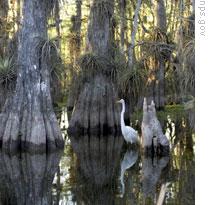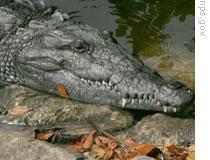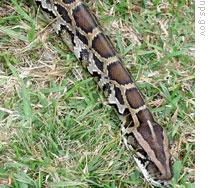2009-6-29
VOICE ONE:
This is SCIENCE IN THE NEWS, in VOA Special English. I'm Faith Lapidus.
VOICE TWO:
And I'm Doug Johnson. This week, we tell about Everglades National Park in the American state of Florida. We also tell about an effort to improve the condition of this important natural treasure.
(MUSIC)
VOICE ONE:
When many people think of Florida, images of sandy coastlines or theme park rides come to mind. But about an hour south of Miami lies a natural wilderness different from anywhere else in the United States.
Everglades National Park is the largest subtropical wilderness in the country. The park is home to several rare and endangered species. It is also the third largest national park in the lower forty-eight states, after Death Valley and Yellowstone. More than one million people visit the Everglades each year.
VOICE TWO:
 |
| An egret in a cypress swamp |
The Everglades is considered one of the great biological wonders of the world. The expansive wetlands stretch across more than six hundred thousand hectares. It is a place where plants and animals from the Caribbean Sea share an ecosystem with native North American species.
Nine different environments exist within the Everglades. They include mangrove and cypress swamps, estuaries and coastal marshes.
(MUSIC)
VOICE ONE:
In the nineteen-forties, Marjory Stoneman Douglas wrote a book called, "The Everglades: River of Grass." She described the area as, "the liquid heart of Florida."
Unlike most other national parks, Everglades National Park was created to protect an ecosystem from damage. The Everglades is home to thirty-six species that are considered threatened or protected. They include the Florida panther, the American crocodile and the West Indian manatee. In addition, more than three hundred fifty bird species and three hundred species of fresh and saltwater fish live within the park. The Everglades is also home to forty species of mammals and fifty reptile species.
VOICE TWO:
Exotic plants can also be found in the Everglades. They include what is said to be the largest growth of mangrove trees in the western half of the world. Gumbo-limbo trees, known for their peeling red skin, strangler figs and royal palms are also among the area's plant life. The Everglades is also home to the country's largest living mahogany tree. Sawgrass grows in some areas of the park. Be careful – it is very sharp, with teeth just like a saw. It can grow up to four meters tall.
With about one and one-half meters of rainfall each year, plants and trees never stop growing in the Everglades. That is why it is hard to tell a powerful storm, Hurricane Andrew, caused severe damage to the area in nineteen ninety-two.
(MUSIC)
VOICE ONE:
 |
| An American crocodile |
Some might enjoy riding bicycles through Shark Valley, while others may want to move slowly through shallow waters where insects and wildlife can be seen up-close. Park guides also lead visitors on tours with tram cars.
VOICE TWO:
This spring, Everglades National Park launched a visitation program to what was once a highly restricted military base. Park officials are working to recover a missile base used in the nineteen sixties. The base played a part in the nuclear tensions between the United States and the Soviet Union.
The government built the Florida base shortly after the discovery of Soviet missiles about three hundred kilometers away, on the island of Cuba. Tensions were high during the Cuban missile crisis. But missiles stored at the American base were never fired.
The base was closed and all missile equipment was removed in the nineteen seventies. Today only the buildings remain.
This year, the historic area had many visitors, including former American service members who remember the missile crisis. The park hopes to offer more trips next spring, to help support the history for those who lived through it and for future generations.
(MUSIC)
VOICE ONE:
Experts say changes to the Everglades are threatening several different kinds of wildlife. They say the threats are a result of actions the United States government began more than fifty years ago, and settlers began even earlier.
The National Park Service says early colonial settlers and land developers thought the Everglades had little value. The settlers had plans to remove water from the area and in the eighteen eighties developers began digging drainage canals. At the time, they did not understand the complexity of the Everglades' ecosystem. As a result, they were not prepared for all the work and caused environmental problems. The ecosystem, however, was able to survive.
VOICE TWO:
Even larger efforts to drain the wetlands continued between nineteen oh five and nineteen ten. Large areas were changed to farmland. This led to increased development, with more people moving to the Everglades and also more visitors.
More changes came in nineteen forty-eight, when Congress approved the Central and South Florida Project. As part of the plan, the Army Corps of Engineers built roads, canals and water-control systems throughout South Florida. The aim of the project was to provide water and flood protection for developed areas and agriculture. Workers built a huge system of waterways and pumping stations to control the overflow of Lake Okeechobee, north of the Everglades.
VOICE ONE:
Today, fifty percent of south Florida's early wetland areas no longer exist. Populations of wading birds have been reduced by ninety percent. Whole populations of animals are in danger of disappearing. The endangered creatures include the manatee, the Miami blackhead snake, the wood stork and the Florida panther.
In recent years, environmental experts have learned about the damage to the Everglades. They say the natural balance of plants and animals has been destroyed.
VOICE TWO:
Recently, the Obama administration promised three hundred sixty million dollars to pay for Everglades restoration this year. The administration is also asking that Congress approve an additional two hundred seventy-eight million dollars for next year.
The money will help to support projects approved by the government nine years ago. The projects include improving wetlands in the Picayune Strand in Southwest Florida and repairs to Lake Okeechobee's dike. Until now, the state of Florida has spent the most money on the project.
VOICE ONE:
 |
| A Burmese python |
Biologists say adult pythons are able to eat small deer and bobcats. When pythons are found in the Everglades, they are often killed. Scientists are now experimenting with other ways to remove the snakes, including trapping methods and offering payments to hunters.
The future of the Everglades is not clear. However efforts to protect the area are continuing so people that from all over the world may continue visiting this biological treasure.
(MUSIC)
VOICE TWO:
This SCIENCE IN THE NEWS program was written by Brianna Blake, who was also our producer. I'm Doug Johnson.
VOICE ONE:
And I'm Faith Lapidus. Read and listen to our programs at 21voa.com. Join us again next week for more news about science in Special English on the Voice of America.